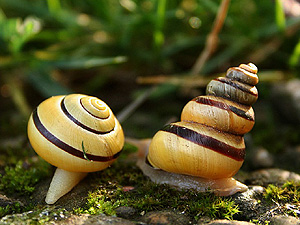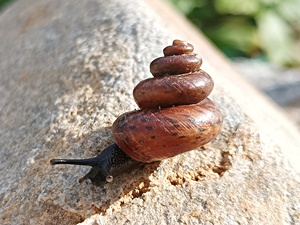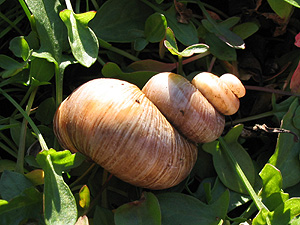![]() The Roman Snail's
Shell.
The Roman Snail's
Shell.
 Normal and scalariform shell in comparison: Cepaea nemoralis. Picture: Gudrun Ruf. |
 Bush snail (Fruticicola fruticum) with a scalariform shell. Picture: Silvia and Christian Bauer. |
|
 A Roman snail with a scalariform shell - an innocuous defor- mity. Picture: Claudia Horstmann. |
In general, the ratio between the width and height of a snail's shell is largely specific for a certain snail species. So a Roman snail's (Helix pomatia) shell is about as wide, as it is high, in a dimension of about 30 to 50 mm. (See also "Identification by Shell Characters").
Among many snail species, there may, though, be a shell deformation, in which the shell is atypically much higher than normal.
The shell whorls are not tightly coiled, like in normal type snails, but stretched along the shell's longitudinal axis and set apart from each other like staircase steps, without a suture between the whorls.
After the Latin "scala" for a staircase, this deformation is called a scalarid or scalariform shell. Apart from Helix snails, scalarid shells can occur among other snail species, even among certain species of sea snails. For the snail, its deformed shell does not impose a life threat, the snail is as viable as any normal type of snail.
So far it remains unknown, how the scalarid deformation of a snail's shell develops. While Geyer wrote in 1927: "by an externally induced disturbance of the suture", much points towards a genetic aberration, as a consequence of which mantle and visceral sac do not grow tightly coiled, but stretched, and so does the atypically elongate shell formed like a staircase.
Clessin in 1873 explained scalariform shells with injuries in the early juvenile stage. Oldham (1931) determined parasitic mites as a cause for scalariform malformations in tree snails (Arianta arbustorum). According to Moor (1983), Zuykov et al. (2011, 2012) and Clewing et al. (2015) scalariform shells can also be the result of ecological stress.
Finally, there is also the possibility of a mutation. Information, however, is lacking, on what kind of mutation this should be. Doležal und Juřičková, on the other hand, were able to prove in an experiment that scalariform malformations in the common garden snail (Cornu aspersum) are not inherited (all 61 offspring of scalariform snails examined had normally built shells) and that besides scalariform snails have no problems to reproduce.